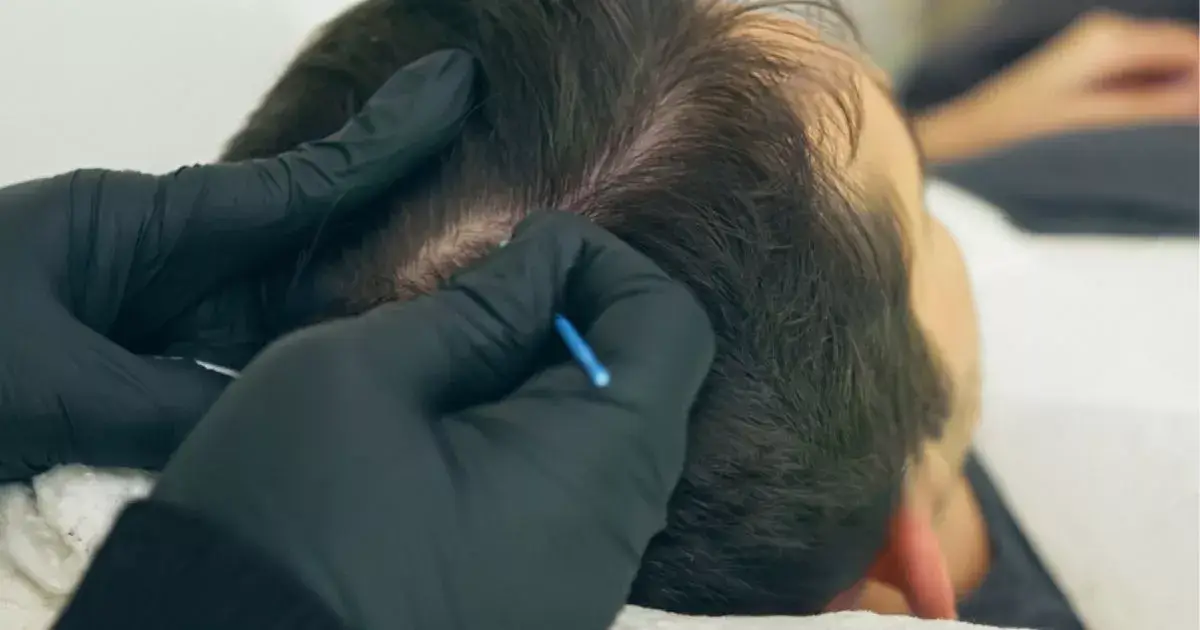Scalp micro-pigmentation (SMP) is a cosmetic technique that involves depositing small precise dots of pigment on the scalp to simulate the appearance of the follicles. The goal of SMP is to create the illusion of a full head of hair, add density to thinning the areas, or camouflage scarring on the scalp
What is scalp micro-pigmentation after a hair transplant and how does it affect you?
Scalp micro-pigmentation (SMP) can be used after a hair transplant to enhance the overall appearance and improve the look of the hair restoration results. After a hair transplant, there may be areas where the hair is thin or where there is not enough hair to achieve the desired density. SMP can help to camouflage these areas by creating the illusion of fuller hair.
SMP can also be used to cover any visible scarring from the hair transplant procedure. When a hair transplant is performed, there may be small scars left behind where the hair follicles were extracted from the donor area. SMP can be used to blend these scars with the surrounding hair and make them less noticeable.
The combination of a hair transplant and SMP can provide a very natural-looking result, with the hair transplant providing the foundation of new hair growth and SMP adding density and camouflage to areas of thinning or scarring.
It’s important to note that SMP should be done after the hair transplant has fully healed and the transplanted hair has started to grow. The SMP artist should also be experienced in working with hair transplant patients and be able to customize the treatment to match the density and placement of the transplanted hair.
If you have scalp pain while moving your hair take a read at our detailed post
What does the procedure look like?
The scalp micro pigmentation (SMP) procedure typically involves several sessions, spaced out over several weeks. The exact number of sessions required will depend on the extent of the hair loss or scarring, as well as the desired results.
During the first session, the SMP artist will work with the client to design a hairline and density pattern that is customized to their individual needs and preferences. The artist will also select a pigment color that matches the client’s hair color, and create a small test patch to ensure that the pigment will blend seamlessly with the surrounding hair.
Once the design and pigment color has been finalized, the artist will use a specialized tattooing device to deposit the pigment into the scalp. The artist will work carefully to ensure that the dots of pigment are placed at the right depth and angle to replicate the look of natural hair follicles.
The SMP procedure is generally considered to be relatively painless, although some clients may experience mild discomfort during the procedure. Any discomfort can be reduced using topical anesthetics.
After the procedure, clients may experience some redness or mild swelling on the scalp, but this typically subsides within a few days. The treated area should be kept dry and clean during the healing process, and clients should avoid excessive sweating and sun exposure for several days after the procedure.
Subsequent SMP sessions will focus on building up the density and perfecting the overall appearance of the treatment area. The entire SMP process can take several weeks to several months to complete, depending on the individual needs of the client.
How soon you can get scalp micro pigmentation after a hair transplant?
The timing of when you can get scalp micro pigmentation (SMP) after a hair transplant will depend on a number of factors, including the type of transplant, the size and location of the transplant site, and how quickly your scalp heals.
In general, it’s best to wait at least three months after your hair transplant before getting SMP. This will give your scalp enough time to heal and for the transplanted hair to grow. If you get SMP too soon, it can interfere with the healing process and potentially damage the newly transplanted hair follicles.
However, it’s important to consult with your hair transplant surgeon and SMP practitioner to determine the best timing for your specific situation. They can assess the condition of your scalp and advise you on the appropriate waiting period before getting SMP.
Is this process alternative to a hair transplant?
Scalp micro pigmentation (SMP) is not a replacement for a hair transplant, but rather a complementary treatment option that can be used to enhance the appearance of hair density and improve the overall look of the scalp.
SMP involves tattooing tiny dots on the scalp to create the illusion of a shaved head or to mimic the appearance of hair follicles. This technique is often used to add the appearance of density to areas of the scalp where hair is thinning and can be an effective option for those who may not be candidates for hair transplant surgery due to a lack of donor hair or other medical factors.
SMP, however, is unable to produce the same organic, long-lasting effects as a hair transplant, which involves moving healthy hair follicles from one area of the scalp to another. A hair transplant procedure involves the transplantation of actual hair follicles, which can grow and fill in areas of balding or thinning hair. The results of a hair transplant are typically long-lasting and can be permanent.
Ultimately, the choice between a hair transplant and SMP will depend on several factors, including the extent of hair loss, the amount of donor hair available, and the individual’s preferences and goals. It’s important to consult with a qualified hair restoration specialist to determine the most appropriate treatment plan for your specific needs.
Get connected with us via Whatsapp for more information about hair transplants or Book a free one to one Consultation

